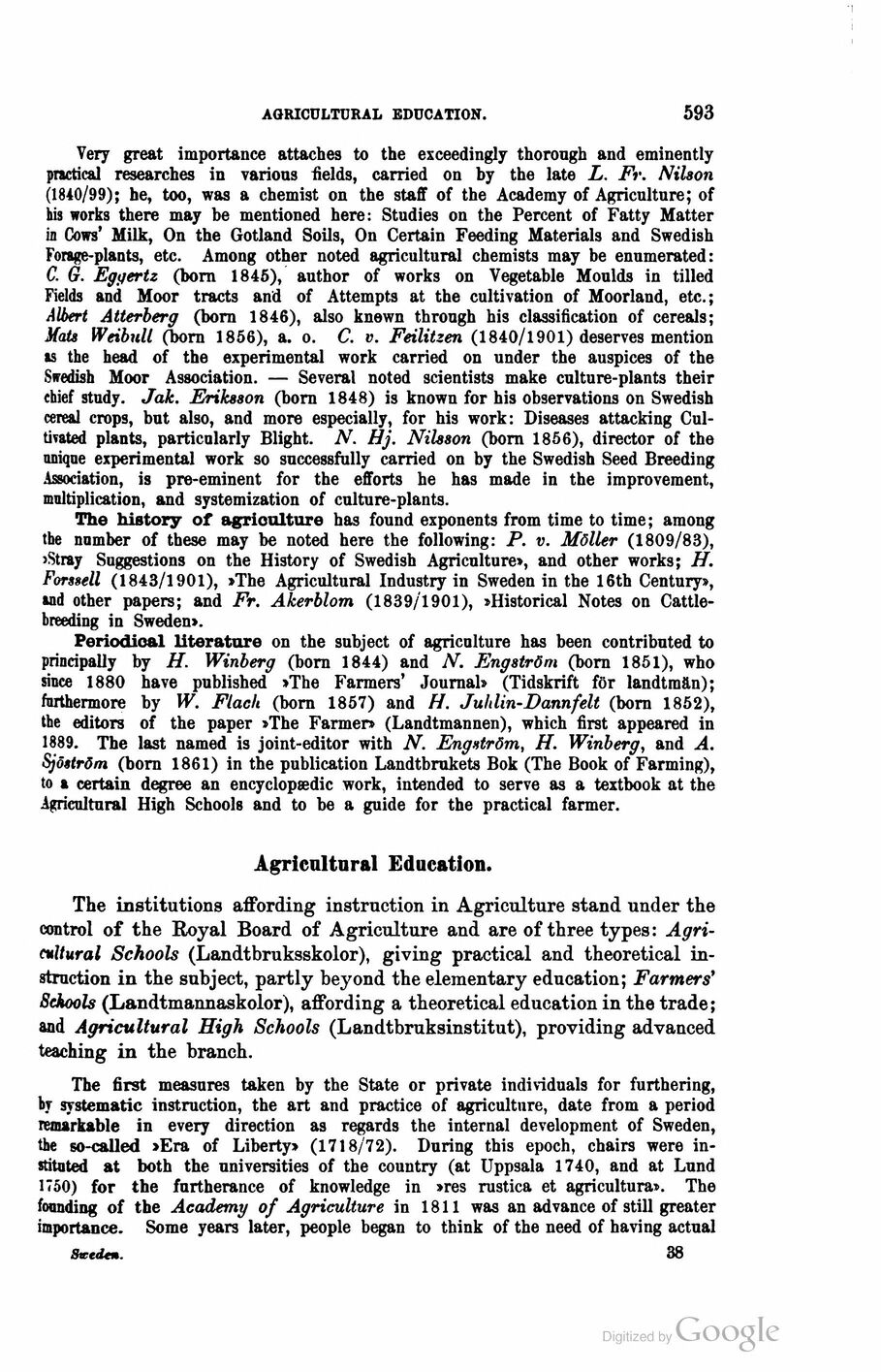
Full resolution (JPEG) - On this page / på denna sida - Second part - VI. Agriculture and Cattle-Breeding - 4. Public and Private Institutions to the Advancement of Agriculture - Agricultural Science, by Prof. H. Winberg, Ph. D., Director of the Alnarp Agricultural High School - Agricultural Education and the Veterinary System, by L. Holmström, Ph. D., Hvilan

<< prev. page << föreg. sida << >> nästa sida >> next page >>
Below is the raw OCR text
from the above scanned image.
Do you see an error? Proofread the page now!
Här nedan syns maskintolkade texten från faksimilbilden ovan.
Ser du något fel? Korrekturläs sidan nu!
This page has never been proofread. / Denna sida har aldrig korrekturlästs.
AGRICULTURAL LEGISLATION.
593
Very great importance attaches to the exceedingly thorough and eminently
practical researches in various fields, carried on by the låte L. Fr. Nilson
(1840/99); he, too, was a chemist on the staff of the Academy of Agriculture; of
his works there may be mentioned here: Studies on the Percent of Fatty Matter
in Cows’ Milk, On the Gotland Soils, On Certain Feeding Materials and Swedish
Forage-plants, etc. Among other noted agricultural chemists may be enumerated:
C. G. Eggertz (born 1845), author of works on Vegetable Moulds in tilled
Fields and Moor tracts and of Attempts at the cultivation of Moorland, etc.;
Albert Atterberg (born 1846), also knewn through his classification of cereals;
Mats Weibull (born 1856), a. o. C. v. Feilitzen (1840/1901) deserves mention
is the head of the experimental work carried on under the auspices of the
Swedish Moor Association. — Several noted scientists make culture-plants their
thief study. Jak. Eriksson (born 1848) is known for his observations on Swedish
cereal crops, but also, and more especially, for his work: Diseases attacking
Cultivated plants, particularly Blight. N. Hj. Nilsson (born 1856), director of the
unique experimental work so successfully carried on by the Swedish Seed Breeding
Association, is pre-eminent for the efforts he has made in the improvement,
multiplication, and systemization of culture-plants.
The history of agrioulture has found exponents from time to time; among
the number of these may be noted here the following: P. v. Möller (1809/83),
’Stray Suggestions on the History of Swedish Agriculture», and other works; H.
Forssell (1843/1901), »The Agricultural Industry in Sweden in the 16th Century»,
and other papers; and Fr. Åkerblom (1839/1901), »Historical Notes on
Cattle-breeding in Sweden».
Periodical literature on the subject of agriculture has been contributed to
principally by H. Winberg (born 1844) and N. Engström (born 1851), who
since 1880 have published »The Farmers’ Journal» (Tidskrift för landtman);
furthermore by W. Flach (born 1857) and H. Juhlin-Dannfelt (born 1852),
the editors of the paper »The Farmer» (Landtmannen), which first appeared in
1889. The last named is joint-editor with N. Engström, H. Winberg, and A.
Sjöström (born 1861) in the publication Landtbrukets Bok (The Book of Farming),
to a certain degree an encyclopaedic work, intended to serve as a textbook at the
Agricultural High Schools and to be a guide for the practical farmer.
Agricultural Education.
The institutions affording instruction in Agriculture stand under the
control of the Royal Board of Agriculture and are of three types:
Agricultural Schools (Landtbruksskolor), giving practical and theoretical
instruction in the subject, partly beyond the elementary education; Farmers’
Schools (Landtmannaskolor), affording a theoretical education in the trade;
and Agricultural High Schools (Landtbruksinstitut), providing advanced
teaching in the branch.
The first measures taken by the State or private individuals for furthering,
by systematic instruction, the art and practice of agriculture, date from a period
remarkable in every direction as regards the internal development of Sweden,
the so-called »Era of Liberty» (1718/72). During this epoch, chairs were
instituted at both the universities of the country (at Uppsala 1740, and at Lund
1750) for the furtherance of knowledge in »res rustica et agricultural. The
founding of the Academy of Agriculture in 1811 was an advance of still greater
importance. Some years later, people began to think of the need of having actual
Swtde*. 38
<< prev. page << föreg. sida << >> nästa sida >> next page >>